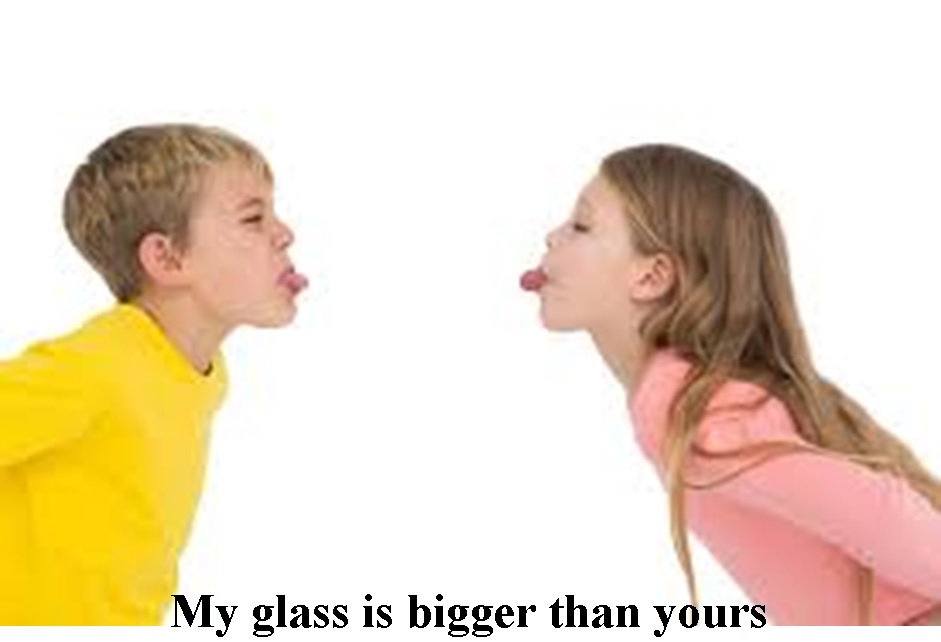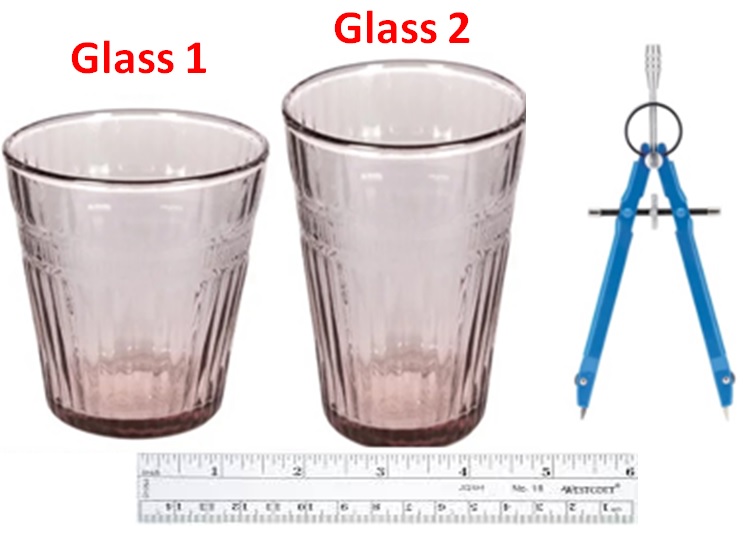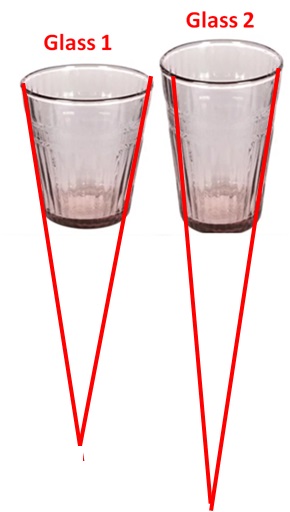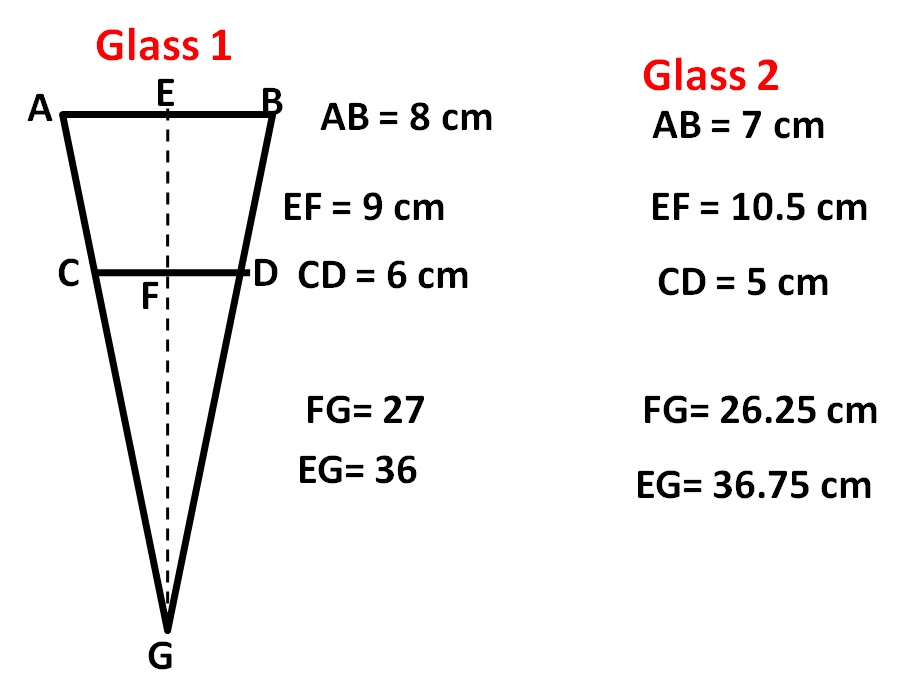
Tanya and Tinku compete over silly things
Tanya and Tinku are close buddies but they compete with each other over silly things. Today, they were drinking water from their own tumbler shaped glasses and suddenly this happened.
Tinku: My glass is bigger than yours.
Tanya: What do you mean ? I see that it is taller.
Tinku: It can hold a larger volume of water than yours.
Tanya: No, it does not.
Tinku: If you are so sure, why don’t you measure it? Here is my geometry set.
How to measure which glass is bigger ?
Tanya: Ok, let’s measure them. We’ll call my glass as Glass 1 and yours as Glass 2. What are you going to measure ?

Tinku; Here, for Glass 1, the internal width of the top is 8 cm, the bottom width is 6 cm and the height is 9 cm.
Tanya: Here, I drew a trapezoid ABCD as a side view of Glass 1. Top side of the trapezoid AB is 8 cm, bottom side CD is 6 cm and I joined the midpoints of AB and CD – E and F. EF is now 9 cm.
Tinku: Now, draw Glass 2 trapezoid ABCD, with the top side AB as 7 cm, bottom side CD as 5 cm and EF is 10.5 cm. See Glass 2 is taller. Okay, smart girl – what are we going to do next ?
Volume of a cone
Tanya: Simple. we will pretend that if we extend the sides of Glass 1, they will join at some point G. Two cones will be formed – the top one with the diameter of 8 cm and the bottom one with the diameter of 6 cm. Glass 1 will be the large cone minus the small cone.

Tinku: You are smart, Tanya. The volume of a cone is πr2h/3 where r is the radius of the cone which would be half of the diameter that we measured but how do we get the heights of the two cones. I suppose, you have some trick up your sleeves.
Tanya: Of course, the trick is called similar triangles.
Volume of a glass as part of a cone
Tinku: Got it, for Glass 1, the triangles AEG and CFG are similar because angles AEF and CFG are right angles and angle AGE and CGF is common. Therefore, there sides must be proportional. Yes, that will work.

Tanya: Yes, let us say the length of FG is x cm. Now AE = 4 cm, CF = 3 cm, EF = 9 cm, and hence EG = 9 + x cm.
Tinku: So (9+x)/x = 4/3 or 27 + 3x = 4x or x = 27 cm which is the length of FG. Therefore, EG = 27 + 9 = 36 cm. That means the large cone has a radius of 4 cm and a height of 36 cm while the small cone has a radius of 3 cm and a height of 27 cm. Now, we can go ding ding ding and get the value of πr2h/3 for the two cones.

Tanya: So the volume of the large cone will be π42 x 36/3 or 604 cm3 or 604 ml. For the small cone it will be π32 x 27/3 or 255 cm3 or 255 ml. Therefore, the volume of Glass 1 is 604 minus 255 or 349 ml.
Tinku: Then for Glass 2, the large cone will be be π3.52 x 36.75/3 or 472 ml, and the small cone will be π2.52 x 26.25/3 or 172 ml. So the glass can hold only 472 minus 172 or 300 ml.
Their friend Kately walks in. She likes to make fun of the jealously of these two and asks what is going on.
Tanya: Tinku was arguing that his glass was bigger than mine. We measured and calculated that my glass was bigger.
Kately filled Glass 1 with water, poured the water into Glass 2. After filling Glass2, some water still remained in Glass1. She said: Why go through this long measurement ? I just showed you which glass is bigger,
Tanya and Tinku shouted together: But how much bigger? You did not show that.
Challenge: Chana joar garam.
In India, you can often buy chana joar garam (spiced roasted black chick peas) on the street. Appu Patel decided to sell it in small conical packets. The roasted spiced chana will cost him Rupees 50 per kilogram. He can buy 100 small cones (2 cm radius and 24 cm length) for Rupees 20. If he sells the chana at Rs. 10 per cone, how much profit can he make per cone assuming that the density of the chana joar garam is roughly 1 g/ml ?
Solution: A cone has a radius of 2 cm and a length of 24 cm. Therefore, its volume will be π22 x 24/3 or 100.65 cm3 or 100.65 ml. The density of the chana is 1 g/ml. Therefore, 100.65 g or let us saay roughly 100 g would fill the cone, At the rate of Rupees 50/kg, the cost of the chana would be 50 x 100 /1000 or Rupees 5. The cost of a cone is Rupees 20/100 or 0.20. Therefore, his total cost per cone of chana joar garam will be Rs. 5.20. If he sells it for Rupees 10, his profit will be Rs. 4.80 per cone.
Solution: The plastic container is 50 cm long, 40 cm wide and 30 cm high. This is the same as saying that the container is 0.50 meters long, 0.40 meters wide and 0.30 cm meters. The volume of the container is 0.06 cubic meters which is the same as 1000 x 0.06 or 60 liters. Obviously, the container is big enough to hold the 10 liter water in the bucket.
You could also do it this way. The volume of the plastic container is 50 cm x 40 cm x 30 cm. This comes out to 60,000 cubic centimeters. One cubic centimeter is the same as 1 milliliter. The volume can be written as 60,000 ml or 60 liters You get the same answer.